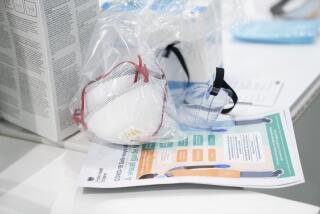Gowns Begone : Disposable hospital garb and other supplies made of a polymer-based material dissolve in hot water.
- Share via
When you wear a skimpy hospital gown, it only feels as if it is shrinking. But now there are organic gowns that actually dissolve--after use.
The innovative technology--also used for surgical drapes and other disposable supplies that hospitals consume voraciously--is expected to drastically reduce the amount of medical trash dumped in landfills.
The paper-thin gowns, similar in texture to Handi Wipes, disintegrate when immersed in hot water.
“This technology will change the way that medical waste is disposed of,” said Rick Setian, a spokesman for Isolyser HealthCare, the company that developed the material.
When one of the new green gowns is discarded by a patient or doctor, it is tossed into an industrial-sized washing machine, heated to 190 degrees Fahrenheit and agitated for 45 minutes. The gown disappears, leaving only a teal-colored fluid, which is drained and pumped to the nearest waste water plant, just like any other dirty water.
The new material, called Orex, is being used to make disposable surgical supplies such as gowns, drapes, sponges and towels. In the future, the manufacturer says, the material may be used to make nonmedical products such as disposable diapers.
The organic polymer used in Orex has long been found in soluble products such as the coating on many pills.
Jack McGurk, chief of the environmental branch of the state Department of Health Services, which approved Orex in March, said the breakthrough puts California at the cutting edge of waste disposal.
California, like many other states, he said, has mandated that health-care facilities and other industries reduce their solid waste volume by as much as 50% by 2000.
“We want to eliminate as much solid waste from the landfills as possible,” said Chris Van Gorder, chief executive officer of Anaheim Memorial Hospital, which he said is the first in the country to use the new product.
Although patients who have checked in since July--when the new gowns and other supplies were introduced--may not have noticed the difference in their skimpy attire, hospital officials say the reduction in disposal costs has been significant.
The 250-bed facility generates about 200,000 pounds of surgical waste a year. With the new procedure, 44% of that--about 88,000 pounds--will literally go down the drain instead of being buried in a dump. That’s a savings of about $18,000 for the hospital.
Dr. Robert Park, medical director of the hospital, said his staff has been very satisfied with the new products.
“If you saw the amount of material that is thrown away every day--for a tonsillectomy or something major, it makes no difference,” he said. “The reduction of such mindless waste is terrific.”
(BEGIN TEXT OF INFOBOX / INFOGRAPHIC)
Waste Generation
Most common waste found in operating rooms nationwide:
Non-woven drapes, gowns: 30%
Suction canisters: 20%
Bandages, sponges, towels: 20%
Plastic bowls, basins: 20%
Various tubes, containers: 10%
Source: Anaheim Memorial Hospital






